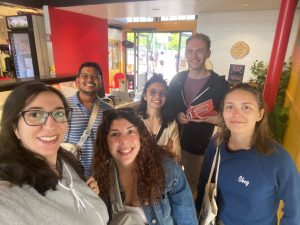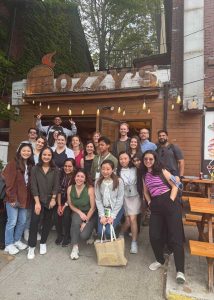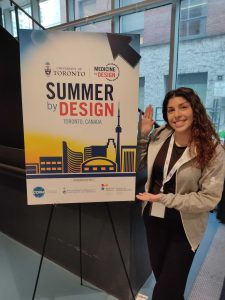Maria Tsalkitzidou is a PhD student at Lund University in Sweden. Her research focuses on neural stem cells and their potential for cell therapy applications for neurological disorders. She specializes in using advanced multiomic techniques to study and characterize neuroepithelial stem cells derived from induced pluripotent stem cells (iPSCs). She is interested in exploring how bioinformatics can be integrated into the development pipeline for stem cell-derived cell therapies.
This summer, I had the incredible opportunity to participate in Summer by Design, an 8-day program hosted by the University of Toronto’s Medicine by Design, in collaboration with CCRM, the Rotman School of Management, and the Stem Cell Network. The program brought together PhD students, postdoctoral researchers, and professionals from around the world, all passionate about regenerative medicine and its potential to transform lives.
What made this experience truly special was its unique focus: understanding the journey from scientific discovery to the commercialization of regenerative medicine. Through lectures, case studies, and interactive sessions, we were guided through every major phase of the process, from pre-clinical research to clinical trials and, eventually, to market access. It quickly became clear that successful innovation in this field requires thinking far ahead. I was surprised to learn just how many strategic decisions must be made even at the earliest stages of research.
The program also highlighted how multi-dimensional the commercialization process really is. It’s not just about having a strong product or robust scientific data. You need to consider clinical translation, product scalability, intellectual property (IP) protection, stakeholder engagement, regulatory navigation, how to position your product in the market, and much more. At first, it felt overwhelming, but the program broke it down in a way that was clear, logical and actionable. I also realized that researchers don’t have to tackle this process alone. From technology transfer offices (TTOs) to contract development and manufacturing organizations (CDMOs), and support from institutions like CCRM, there’s a strong ecosystem of resources available to help researchers move forward. Coming from Europe, and specifically Sweden, it was fascinating to experience Toronto’s biotech and commercialization ecosystem and consider how it might connect with opportunities back home.
As a PhD student in a lab that focuses on the regenerative potential of iPSC-derived neural stem cells and their potential as an advanced therapy medicinal product (ATMP) for cell therapy applications for neurological conditions, Summer by Design seemed like a perfect fit. Even though my research focus is still at a preclinical stage, I thought it would be beneficial to learn more about the commercialization process. And I was right!
One of the most inspiring parts of the program was hearing directly from individuals who have walked the commercialization path themselves. We listened to the stories of founders who launched startups in the regenerative medicine space, one while still completing her PhD! It was truly inspiring to listen to her. Hearing how everyone transitioned from academia to industry, navigated funding hurdles, and built successful companies was both eye-opening and deeply motivating. One key takeaway for me was the importance of market alignment. Even the most promising product won’t succeed without a well-defined need and a target audience. But perhaps the most powerful message was that you don’t have to do it alone. A strong, multidisciplinary team can make all the difference.
Another valuable component of the program was the focus on scientific communication. Throughout the week, we received coaching on how to present complex ideas in an accessible and compelling way. We put our skills to the test with a friendly scientific storytelling competition, where we were challenged to explain our research in just three minutes. As someone who doesn’t usually enjoy public speaking, I found it both challenging and rewarding. It pushed me to step back from the technical details of my research and view it from a societal perspective, focusing on why it matters beyond the lab. The feedback I received was constructive and encouraging, and I know I will continue to try to implement what I learned to refine my communication skills in the future.

 Beyond the lectures and workshops, what truly enriched the experience were the people. I had the chance to meet fellow researchers from all over the world, all united by a shared interest in regenerative medicine. The program did a fantastic job of bringing us closer, even in this short period. We explored restaurants in the city, visited the Art Gallery of Ontario, took part in a pub trivia night, spent a day at Niagara Falls and even attended a Toronto Blue Jays game, with box seats kindly provided by CCRM. These connections made the experience all the more memorable, and I have no doubt our paths will cross again in the years to come!
Beyond the lectures and workshops, what truly enriched the experience were the people. I had the chance to meet fellow researchers from all over the world, all united by a shared interest in regenerative medicine. The program did a fantastic job of bringing us closer, even in this short period. We explored restaurants in the city, visited the Art Gallery of Ontario, took part in a pub trivia night, spent a day at Niagara Falls and even attended a Toronto Blue Jays game, with box seats kindly provided by CCRM. These connections made the experience all the more memorable, and I have no doubt our paths will cross again in the years to come!
One of the final highlights of the program was a guided tour of CCRM’s state-of-the-art facilities. Seeing the infrastructure that supports regenerative medicine commercialization brought everything we had learned into a real-world context. It was a fitting end to a program that consistently balanced theory with application.
All in all, Summer by Design was an inspiring, challenging and transformative experience. I left with a broader perspective on the innovation and commercialization pipeline, practical tools to communicate my science more effectively, a new worldwide network, and a renewed sense of purpose as I continue my journey in regenerative medicine. So far, it’s possibly the most valuable program I’ve participated in during my PhD.
I would definitely recommend this program to everyone interested in translating their science and reaching patients, even if this goal seems distant!
Guest
Latest posts by Guest (see all)
- Regenerative immunotherapy: Hope for chronic autoimmune diseases - September 16, 2025
- Canada’s regenerative revolution: Why AI is the catalyst - September 4, 2025
- Summer by Design: A launchpad for future entrepreneurs and industry scientists - August 14, 2025







Comments